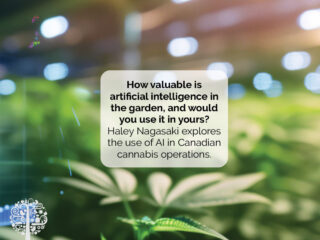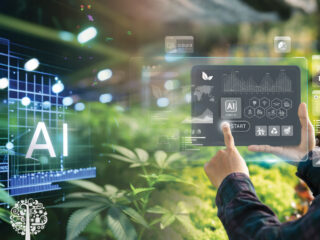Already being leveraged by Big Ag, artificial intelligence (AI) increases the precision of commercial cultivation, intended to simplify and streamline. For cannabis production, tech companies market AI-driven machine learning to growers for scouting and temperature detection tasks. But how prevalent is AI in Canadian cannabis operations, and who is growing with AI in the garden?

Yet to Peak
I’ve spoken to cybersecurity professionals specializing in the cannabis space and polled a sample of quality assurance specialists from Canadian LPs about AI applications. For reasons pertaining to budget or skepticism, my findings were that AI in Canadian cannabis has not yet peaked. There may also be security gaps that could be reconciled using new technology. However, regarding cultivation, some AI applications could offer producers a boost.
Pros and Cons
The trepidation felt in AI’s orbit is warranted.
How far is too far? What dictates overreliance, and how could dependency ultimately lead to catastrophe?
On the contrary, how much time could be spared, and what menial tasks should operators be relieved of while increasing precision and mitigating human error? Most firms would see the necessity of AI applications to remain competitive in the market.
Integrating automation into AI has replaced some manual applications, operated through apps on the cultivation team’s phones. And for good reason. Surveillance, real-time updates, and data synthesis are areas where AI shines and simplifies our lives. While automation repeats the same task over and over, AI responds to new information, enabling it to deduce a new kind of thinking and decision-making. But how much could machine learning infiltrate the sector? Let’s look over to the mainstream.
Commercial Ag
Assessing environmental factors is critical for crops and contributes to crafting precise predictions. For scaled automated growing systems, think greenhouses and vertical farming with continuous plant health screening and input monitoring.
Scouting alerts growers of pests, crop deficiencies, and hot spots and assists with calculations related to resource allocation. Predictive analytics can gauge crop yields, while robotic planting and harvesting can reduce labor costs. Other less colorful topics surrounding AI in the cannabis supply chain include inventory management and quality control. Keeping networks safe and secure is currently one of the most meaningful roles for AI in agriculture.
For the biological components of smart farming, AI occupies more of an assistant role than a director. But as some globalists and leaders have forecasted, at what point and on which timeline does this occupation of the workforce push humans towards basic income?
Is UBI our Future?
Picture a sprawling monoculture with drones scouting overheard in support of smart cities. It’s creepy, but like anything else in the globalized world, the impetus for streamlining processes and simplifying daily tasks (doing more with less) has been sluffed off onto machine learning to free up brain power. Could it instead be making us lazy? Could we eventually begin to atrophy? What will happen to muscle memory?
While there’s still plenty of hand-watering (yay), cannabis companies’ use of AI depends on their scale and scope and the owners’ ideations and willingness to employ machine learning.
I would guess we have an idea of where we’re at with the potential runaway technology, where it stands in relation to our daily lives and businesses, and some inklings about where it might be headed. There might also be some overwhelm attributed to the proliferation of AI, and from personal experience, feelings of overwhelm often push me into the garden.
Organize with Nature
The garden is the meeting point where humanity organizes with nature. It’s also where I leave my phone behind (unless I’m taking pictures for social, which is most of the time..) For the hobby grower and gardener, there’s beauty to being set free without an SOP and tracking with nothing more than pen and paper. I go to the garden to disconnect and reconnect.
The folk medicine maker eyeballs the measurements of their salves and tinctures. The fertilizers might be free-poured, the compost teas spread generously, and the Korean Natural Farming protocols are the definition of chaos gardening.
The chaos gardener creates magic in cocreation with the brilliance of nature and the beauty of their intuition.

Striking Balance
AI, like everything else, requires boundaries. Balance is the key to any polarizing topic.
Is AI in the garden even relevant to the home grower? The chalk white block timers are still available for purchase like they were decades past. A sprinkler timer seemed revolutionary for watering the backyard garden while on holiday. The chaos gardener bubbles worm castings, kelp powder, and molasses in a tote bin in the backyard, then hand bombs five-gallon buckets of microbial stew to the basement grow, all while sweating in a straw hat and bathing suit.
For me, this is the joy of gardening. I want to scour for pests and research when my plants are stunted or experiencing chlorosis. I want to mark the date and journal about my garden’s exponential growth after I drove to Black Swallow Living Soils in Niagara for biochar and barley mulch.
I don’t trust an app on my phone to identify edible plants or fungi. I’d rather reach into my community and network of growers and researchers and dogear our conversations. As a home grower and gardener, I use nature to escape tech, not vice versa. And I lean into the nuances of community for innovation.
From Big Ag, commercial crops, and small-scale ops to market gardens, community farming and cooperatives, hobby growers, and enthusiasts, we all use machine learning to different degrees. However, a clear divide between the two rather than total integration might help us better adjust our monkey minds to the realities of AI.
Cresting with the rest of society on this might be advisable; neither lagging nor being first to the party. And sticking to our gut instincts and values will always set our abilities apart from an artificial mind.